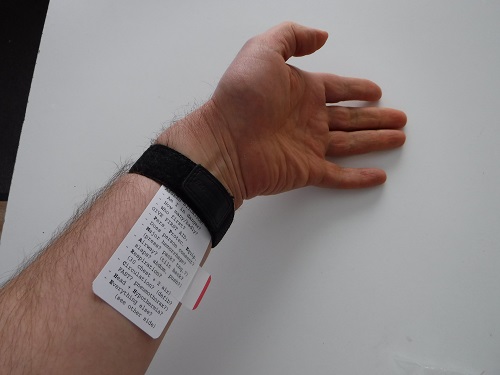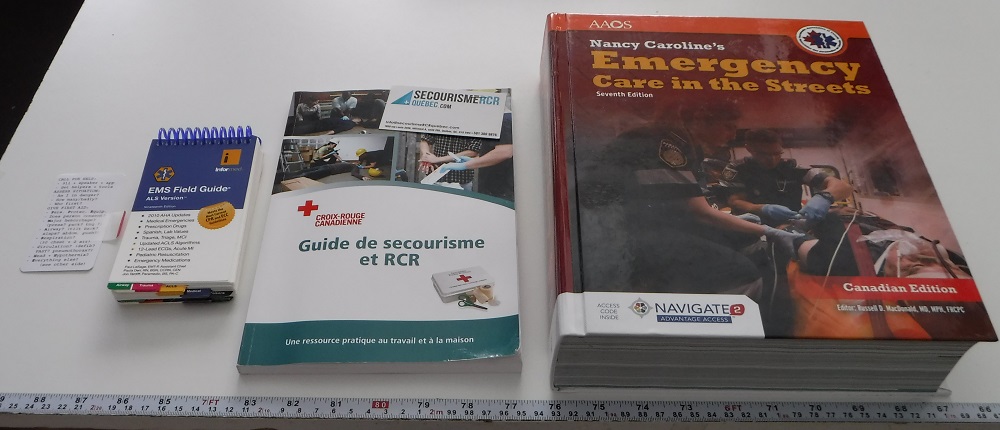
Let's Adore Jesus-Eucharist! | Home >> Varia >> Bachelor's Kit

About a week ago, I took a two-day first aid course, based on the Red Cross manual. One of the things that struck me is what you might call the "EPSB syndrome" (for "Emergency Pea-Sized Brain"!). In other words, during the part of the course where the teacher would simulate emergencies and where the students would need to react with what they had just learnt, my brain just shrivelled to the size of a dried pea when my turn came up.
Think about it. All the knowledge was fresh (this was the last afternoon of the two-day course). There was no real stress (the teacher would just pretend to choke, or to have fallen from a high location, or to have a heart attack, etc.). We were in a classroom that was quiet, lean, well-lit, heated at the right temperature, etc. (i.e not outside in the freezing wind, or in a house on fire, or in the middle of a highway, etc.). And I already knew most of this stuff anyway...
So I figured a cheat-sheet that I had with me all the time would be better than nothing. And the only cheat-sheet I have room for in my EDC is something the size of a credit card (technically ISO/IEC 7810 ID-1).

Who says you can't peek at your cheat sheet while giving first aid?
Ideally this cheat-sheet would be professionally printed on a plastic card with rounded corners. I currently just have them printed (both sides) on blank business cards "tear-apart" sheets, then round off the corners by hand. Also, since pulling out a business card requires fine motor skills, I added a big red tab with "Grab your brains!" written on it, to make it very easy to pull out of my wallet.
Please note that this has not yet been reviewed by medical doctors, nor even certified Red Cross first aid instructors.
|
1CALL FOR HELP:
|
(start other side)
|
Of course you cannot fit all first aid knowledge on a small business card, even if it's printed both sides, and even if you use many abbreviations and acronyms! So there are necessarily many compromises and omissions. I'll now try to explain the first few (the rest is mostly taken from the Red Cross manual we were issued).
4.1) CALL FOR HELP. In our course, calling for help was not the first thing we were supposed to do. Among other reasons, they don't want us to call 911 for trivial things like a nosebleed or a twisted ankle, which of course I agree with. But calling first (with some electronic communication device and/or plain old human voice) has many advantages, some of which are listed below. I insisted more on "smartphones" since they are getting so ubiquitous and advanced.
4.2) 911. Of course, in countries where dialing "911" is not the correct way of contacting emergency services (paramedics, firemen, policemen, etc.), the correct number must be substituted.
4.3) speaker(phone) or hands-free. A modern smartphone has a "hands-free" feature, and also any portable phone can be geolocated (i.e. its position on the planet is knowable, because of the very way cellular telephone networks are designed). So if you call 911 and leave your phone open with the "speakerphone" feature turned on, you get several immediate advantages: they know there is an emergency (you're calling 911!), they can know where you are (at least roughly), and with a bit of luck they can even walk you through the first aid you should be giving!
4.4) app. The Red Cross already has a rudimentary first aid app, but sooner or later a real first aid app will be written. This app will have all the "intelligence" to respond to a first aid situation. Because most smart phones have voice recognition, the app will be able to walk you through the first aid algorithm, like "is the person breathing?", "NO!", "Clear airway!", "HOW?", "Tilt back head!", etc. The computer could walk you through CPR, counting the number of times you push on the chest, reminding you to give two breaths after each 30 chest pushes, etc. Right now the Red Cross app is more like a book, whereas it need to be more like a coach that talks to you and tells you what to do, and how to do it. Computers are already transforming the way we do almost everything, so "Computer-Assisted First Aid" is the way of the future, because a computer is the closest thing to a "brain enhancer" you can get.
4.5) Get. You wouldn't spend more than a few seconds recruiting people and equipment, but once these types of requests are made, they can continue spreading and what you asked for can be transported back to you, while you're doing something else.
4.6) helpers. There could be people more knowledgeable than you in first aid, if you just ask! Not just doctors, but friends and family of the victim, witnesses of the accident, etc.
4.7) tools. First aid kit, AED (Automatic External Defibrillator), etc.
4.8) ASSESS SITUATION. Given that you only have a few minutes before serious casualties die (for example if the have stopped breathing), this taking stock of the situation must be done in a few seconds. I'm not saying it's easy! But it's probably worth while to avoid focusing on the first screaming or bloody object that catches your attention, and to try to "absorb" the whole situation before "diving in".
4.9) Am I in danger?. Are you in a burning building which is about to collapse? or in the middle of a highway? or in the firing zone of an active shooter? etc. This is not to say heroism is forbidden. Maybe you should risk your life and run into that burning building! But if you are just going to add another death to the event (i.e. if your chances of success are practically nil), you should probably try another approach. This might just involve taking a few seconds more to get the proper equipment or procedure. Like getting an oxygen mask and bottle before running into the burning building, so you won't just choke and die on the toxic fumes, or blocking incoming traffic with your car before getting out and helping the victim of a car accident, so incoming cars will stop, etc.
4.10) How many/badly?. This is not saying you have to take several minutes per person to give them a full examination! At this stage, it means more like finding out if there are not other casualties that are not immediately visible, and who need help even more, etc. Try to take a few seconds to get a count and at least one look at each person, without missing anyone. Of course, if it's only one person in front of you having a stroke, you can skip over many of these steps.
4.11) Who first?. I.e. "triage". Start by eliminating both extremes, the ones who are dead or who will probably die anyway, even if you invest all your time and equipment, as well as those who can probably just walk away and take a taxi to the hospital. Then for the rest, try to order your work such as to save as many people as possible (most benefit for the least time invested).
4.13) PPE (Personal Protection Equipment). Gloves, glasses, mask, etc.
4.15) MARCHE acronym. Taken from "Tactical Emergency Casualty Care (TECC): Guidelines For The Provision Of Prehospital Trauma Care In High Threat Environments".
4.22) Second side. Notice the first side corresponds with the "primary examination" and the second side with the "secondary examination" (Red Cross manual).
4.23) SAMPLE acronym. Taken straight from the Red Cross manual.

First aid "cheat sheets", from credit card sized to 1700 pages weighing several kilograms.
Ideally the Red Cross would issue such a card with their first aid manual, and each word on the card would correspond to a sub-chapter, so reading through the card would be a bit like re-reading the whole manual.
Also, even though I would dearly try to use this card (or some better memory aid) in case of an emergency, it's main purpose should be to help you practice for an emergency! Ideally you would ask someone else to program your smartphone to trigger an alarm at some point of time in the coming days, and when that alarm sounded, you would have to imagine some emergency has occured, and you would need to respond to it, right there right now.
Let's Adore Jesus-Eucharist! | Home >> Varia >> Bachelor's Kit